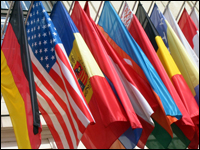Later this month, a mess of world leaders will be gathering in Montreal to discuss climate change. The conference is a rendezvous — we must use French words when speaking of Quebec — of COP 11 and MOP 1. And it has to do with the Kyoto Protocol! Isn’t that mysterious and intriguing?

One of these things just doesn’t belong … to Kyoto.
If you’re not on the edge of your seat yet, let us spell it out for you: this meeting is quite important, in that future-of-the-earth kind of way. And once we’ve broken it down for you, you’ll be knowledgeable enough to, well, care.
It all started in Rio (doesn’t everything?). Long, long ago (1992) and far, far away (Rio de Janeiro, Brazil), the United Nations Framework Convention on Climate Change (UNFCCC — memorize this acronym, because it’ll be coming up a lot) was produced at the United Nations Conference on Environment and Development, informally known as the Earth Summit.
The UNFCCC was a non-binding treaty aiming to address global climate change. It was eventually ratified by 189 countries, including all the world’s developed countries — yes, even the U.S. These countries agreed to work together to stabilize the amounts of greenhouse gases in the atmosphere and prevent dangerous human interference in the global climate.
And then the conferences began. For countries, a perk of signing and ratifying a convention is being invited to regular dates to make sure the convention meets its goals. These meetings are called Conferences of the Parties (COP). Grist suspects that countries might also hold regular Parties of the Parties (POP!), complete with cake and balloons. But not being a country, we’ve never been invited.
By March 1994, enough parties had ratified the UNFCCC that the shindigs — er, the conferences — could begin. The first Conference of the Parties, creatively called COP1, was in Berlin in 1995. COP2 was held in Geneva in 1996, and COP3 in Kyoto in 1997. Not much happened there. COP4 was in Buenos Aires … ho ho, just trying to keep you on your toes! That Kyoto meeting was a doozy!
Enter: the Kyoto Protocol. Kyoto is Tokyo spelled sideways. Not that that matters; just something we’ve noticed. Now where were we? Oh yes. A binding legal agreement negotiated by parties to an existing convention can be called a “protocol.” So the Kyoto Protocol was a protocol created at COP3 in Kyoto. Got it? We’re not sure whether to thank the U.N. for keeping it easy for the laypeople, or chide them for their lack of creativity.
Under the Kyoto Protocol, the world’s Annex I, or developed, countries — including the European Union, the United States, Canada, Japan, Sweden, Norway, New Zealand, Australia, and Russia — would accept binding targets for reducing emissions of six greenhouse gases: carbon dioxide, methane, nitrous oxide, hydrofluorocarbons, perfluorocarbons, and sulfur hexafluoride.
These Annex I countries also bound themselves to paying for and supplying technology to developing countries for climate-related studies and projects. Emissions trading was given a big thumbs up. The ultimate goal: if somebody with a really cool calculator averaged the emissions of industrialized nations between 2008 and 2012, that average would be 5.2 percent below what the person with the really cool calculator found in 1990.
Exit: the U.S. The protocol could not become legally binding until at least 55 countries ratified it, including enough developed countries to account for 55 percent of 1990 greenhouse-gas emissions from developed countries. Got that? Basically, enough big guns had to sign on to make it worth everyone’s time and effort. In 2001, only a few months after taking office, U.S. President George W. Bush announced that the U.S. would not ratify the protocol, and thus not be bound by it. Grist was not consulted in this decision — nor, for that matter, was the head of the U.S. Environmental Protection Agency.
Was the Kyoto Protocol dead? The tension mounted … the rumors flew … and then Russia stepped in to save the day, ratifying the protocol in November 2004 and thereby pushing the group of participating countries past that 55 percent requirement. The Kyoto Protocol went live 90 days later, on Feb. 16, 2005.
Which brings us to today. Actually, into the future — ooh, time warp! Montreal 2005 will kick off (in style, no doubt) on Nov. 28. It will be the 11th Conference of the Parties to the UNFCCC (COP11). It will also be the first Meeting of the Parties who ratified the Kyoto Protocol (MOP1). See? That wasn’t so hard.
The Honorable Stephane Dion, Canada’s Minister of the Environment, will chair the conference, commencing his one-year tenure as president of the COP. The U.S. delegation will be headed by Paula J. Dobriansky, undersecretary of state for democracy and global affairs. The U.S. will have a vote in COP issues, but not in MOP issues. (Because they’re part of COP, but not MOP. Remember?)
Sounds like a fun event, but here’s the bad news: while as many as 10,000 people will be there, you’re probably not one of them. Montreal 2005 is open only to representatives of countries who are parties to the UNFCCC, observer states, U.N. bodies, NGOs that have been formally admitted as observers, and accredited media. However, there will be associated events that are open to you, your cousin’s cousin, and your Aunt Sally. And unofficial rabble-rousing too.
So go whoop it up! And bring us back a balloon.
For the latest news articles on COP11/MOP1, see the Northern Climate ExChange. For more on the original UNFCCC, see Understanding Climate Change: A Beginner’s Guide to the U.N. Framework Convention. For more on Montreal 2005, see the Sierra Club of Canada’s A Planetary Citizen’s Guide to the Global Climate Negotiations, or How to Use a Mop [PDF].


